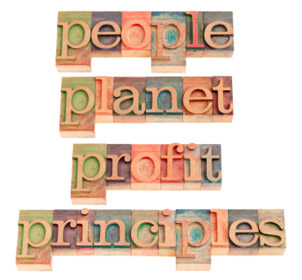Enlisting an Army of Givers: Socially Conscious Consumers & Change
It seems with every passing year the world moves toward a more socially responsible and sustainable economic ecosystem. Finally, after much progress, the locomotive of change has begun to move and gain momentum. At one end of the movement are the vast array of ecological stewards, who approach sustainability with an eye toward preserving the natural human experience. On the other end are businesses – producers of everything people use to create their own personal standard of living – that have begun to realize their work can be done in a different, better way. This includes understanding that necessary economic activities can have a limited negative impact on society and ecology while being more agreeable to consumers purchasing products. With this in mind, the end goal is to ensure purchasing decisions will not solely be based on price and utility but also on factors that enhance the public good.
The phrase “people, planet, profit,” coined by John Elkington in 1995, perhaps best defines the economic rationale behind the social responsibility and sustainability movement. The focus on these “triple-bottom line” (TBL) measures emerged as large, multi-national corporations determined that focusing on all organizational stakeholders, rather than just stockholders, could potentially provide a more sustainable business model. While free market capitalists left to act on their own may not have aspired to develop a focus on the “people” and “planet” components of TBL, the marketplace began to speak loudly in favor of a more balanced approach.
The number one lesson of business schools is that in order to be successful within the free enterprise system, a firm must provide goods and/or services, which address marketplace needs at a price consumers are willing to pay. The number two lesson is that the price accepted for the good or service must result in an adequate return to shareholders. Since the dawn of the Industrial Age, great companies have been built by following these two lessons, and countless shareholders have benefited richly from their success.

© iStockphoto.com/marekuliasz
So, why have so many corporations adopted Corporate Social Responsibility (CSR) and sustainability policies throughout the past two decades? Very simply, the calculus used by the consumer to determine value received from a good or service now includes consideration of how “people” and “planet” are impacted. Consumers have graduated to a level where they are seeking assurances that negative impacts to planet and people as a result of the supply chain are being mitigated. Therefore, it can be argued that marketplace movement toward more socially conscious and sustainable goods and services is not the result of a departure from the free enterprise system but rather a natural consequence of it.As the army of consumers interested in social good begins to force marketplace change, how can the movement expand from a “worthy endeavor” to a “way of life” for more individuals?
As the world moves toward a more socially responsible and sustainable economic ecosystem, how can more businesses be encouraged to integrate these concepts into practice? One way may be through non-profits since the health and viability of the social responsibility and sustainability movement depends on more than just energized consumers and forward-thinking businesses.Non-profits are staffed with “thought leaders,” who immerse themselves in emerging, relevant issues, and personnel dedicated to educating masses on how to approach decision-making. In the same manner that higher education provides research that evolves into commercially viable products and services, non-profit organizations develop new methods for influencing the social and ecological fabric adopted by consumers and businesses worldwide. Their advocacy, or disapproval, of certain actions within the marketplace can guide consumers and stakeholders on a path to foster the movement. To that end, securing resources for their mission is critically important. So, if the fundraising capability of non-profit organizations is the mother’s milk of the movement, then how is it possible to ensure this steady supply of funding on their behalf? Businesses, foundations, grant givers and wealthy donors have traditionally supplied large scale donations, but another way exists to assure the transition from “worthy endeavor” to a “way of life” – an “army of givers.”
Clearly, many non-profit organizations, which have served as the backbone of the social responsibility and sustainability movement, have tended to focus on issues surrounding negative ecological impacts of processes used to manufacture and deliver goods and services. But, many have advanced well beyond the ecological focus to find ways to work with the world’s producers to understand and mitigate the impact their actions have on individuals at all levels of their supply chain. Through information and advocacy, non-profit organizations take on the indirect role of protecting society from a myriad of negative effects, such as dangerous conditions in the workplace.
These are worthwhile endeavors to be sure. However, playing defense in the “people” aspect of Elkington’s construct may not provide the credibility the movement needs to evolve mainstream. Is it sufficient to expect certain economic activities to do no harm, or should society go from defense to offense and reverse that course, valuing endeavors that add benefit to lives as a result of the production of goods and services? Some would say that for Elkington’s construct to be fully implemented, the “people” element needs to be expanded to include such offensive actions.
One example is provided by non-profits that support active duty military personnel and veterans. Such organizations not only possess a socially conscious strategy based upon mitigation of negative effects on the “people” component of Elkington’s construct but also on the constructive aspects. The mission of all branches of the United States military is to protect the people, interests and territory of the United States of America. Millions have devoted their lives to carry out this mission, with many making the ultimate sacrifice to secure and maintain freedoms all Americans enjoy today.

© iStockphoto.com/pearleye
For illustration purposes only, if the military is viewed as a large business with the citizenry as its consumer, safety and security as the services produced, and active duty and veteran military personnel as members of the supply chain impacted by production, then it is reasonable to assume that Elkington’s construct can also be used to analyze this environment. Non-profit organizations that adopt missions related to support of active duty and veteran military personnel are almost exclusively focused on mitigating negative effects on individuals in the supply chain. While Congress is keenly interested in what might equate to the “profit” aspect of the defense industry, and various military departments increasingly focused on the “planet” aspect, veteran-related non-profit organizations are almost exclusively focused on the “people” aspect. It is unquestionable that work being done by these non-profits affects future generations who may be considering a career in the military.
Parents who help their children make such decisions are certainly watching the degree to which America’s current military is being treated and its returning military personnel assisted in their transition back to civilian life. These type organizations, and their examples, provide the first step in the movement to make sustainability part of the thinking of socially responsible companies. With that in mind, the movement is well underway; educated and socially conscious consumers assure that. The immediate challenge ahead is to ensure non-profit organizations that research, educate and advocate on behalf of social and ecological good are well funded, military or non-military. And the capstone of the movement may well be achieved when consumers, with the assistance of non-profits, can be relied upon not just to admonish bad behavior among producers but also to encourage actions that reverse course and add value to society as a whole. As mentioned, those joining this socially responsible and sustainable movement need look no further than the non-profit organizations that benefit military personnel to understand and see a model for how to make this work.




























